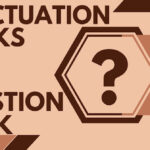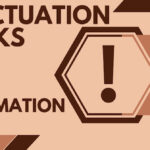Introduction
Good writing isn’t just about conveying coherent thoughts; it’s also about effectively communicating those thoughts to the reader.
This is where punctuation comes in.
Punctuation marks are symbols used in written communication to indicate pauses, emphasis, and other elements of meaning that are conveyed through tone of voice, gesture, or other nonverbal cues when speaking.
Without punctuation, written texts would be difficult to read and even more challenging to understand.
Definition of Punctuation Marks
Punctuation marks are a set of symbols that include commas, periods, questions marks, exclamation marks, colons, semicolons, quotation marks, parentheses and brackets – to name a few.
Each mark has its own specific function within a sentence that helps convey meaning and control the pace of the text.
The use of punctuation varies among different languages and cultures but some basic principles remain the same
For Example:
capital letters usually begin sentences with periods at the end; commas separate items in lists or clauses in compound sentences while semicolons can be used instead if there are already many commas present.
Importance of Punctuation in Written Communication
Punctuation plays a crucial role in written communication because it helps readers understand what writers intend to say.
Consider this sentence: “Let’s eat grandma.” The absence of a comma drastically changes the intended meaning: “Let’s eat grandma” versus “Let’s eat comma Grandma.”
In addition to clarifying meaning for readers or listeners , proper punctuation makes writing more aesthetically pleasing by breaking up long blocks of text into smaller chunks which allows readers’ eyes rest between phrases.
It also gives writers control over how fast their audience reads their work–by using question marks or exclamation points we can emphasize important words or make them stand out from others around them.
Without proper use of punctuation marks writing may be difficult to read and comprehend, it may lose meaning or become ambiguous; but when used correctly, punctuation enhances the beauty and clarity of written communication.
Overview of the slash mark (/)
The slash mark (/) is a commonly used punctuation mark that has several functions in written communication.
It is a versatile symbol that can be used as a separator or alternative for words, phrases, and even entire sentences.
The slash mark consists of a forward-slash (/) that is placed between two items to indicate a separation or choice between them.
This punctuation mark has many applications in writing and can be found in various types of texts.
Explanation of the slash mark’s function as a separator or alternative
The primary function of the slash mark is to serve as a separator or alternative for words, phrases, or sentences.
It indicates that there are two options available and either can be used interchangeably.
For example, when indicating alternatives such as “he/she” or “and/or,” the slash serves as an option marker; it implies either option can be chosen according to preference.
In terms of separation, one could use slashes to signify different lines on an address (31/32 Example Street).
The separation could also apply to lists where slashes differentiate items.
Examples of common uses in writing
There are many common uses for the slash mark in written communication which include:
1. Abbreviations:
Slashes can replace abbreviations like w/ (with), b/w (between), and e.g./i.e.(example/in other words).
2. Fractions:
The forward-slash symbolizes fractions–for instance, ⅓ indicates one-third.
3. Dates:
In dates where numerals indicate days/months/years separated by slashes–e.g., 01/07/2021 means January 7th, 2021.
4. Poetry:
To denote line breaks when quoting poetry–e.g., “Two roads diverged in a wood,/And I took the one less traveled by.”
5. Programming:
The slash is used to separate parts of code in programming languages.
6. URL’s:
Slashes are used to separate directories and subdirectories on a website’s URL.
These are just a few examples of how the slash mark is commonly used in writing.
It is important to use this punctuation mark properly; overusing it may make your writing seem disorganized and unprofessional.
However, when used appropriately, the slash can add clarity and meaning to your text.
Uses of the slash mark in detail
The slash mark (“/”) has a variety of uses, making it a versatile punctuation mark in written communication.
In this section, we will explore each use in detail.
Separating options or alternatives
One of the primary uses of the slash mark is to separate options or alternatives.
For example, if someone is deciding what to wear for an event and cannot choose between two articles of clothing, they might say “I can’t decide whether to wear a dress/skirt tonight.”
The slash mark indicates that either option is acceptable.
Indicating fractions or dates
Another common use for the slash mark is to indicate fractions or dates.
For example, “The meeting will take place on 5/12/2021.” In this case, the slash separates the day, month, and year.
Showing line breaks or pauses in poetry or song lyrics
In poetry and song lyrics, the slash mark can also be used to indicate line breaks or pauses.
For instance: “Oh say can you see / By the dawn’s early light…”
This usage allows singers and readers to pause at specific moments during a piece.
Representing shorthand for “or” and “and”
The slash mark can also represent shorthand for certain words like “or” and “and”.
For instance:
“Please bring your ID/passport and visa/immigration documents.”
In this context, the sentence means that two sets of documents are required – either an ID card OR passport must be presented along with visa OR immigration documents.
Denoting emphasis or contrast
Another use for the slash mark is denoting emphasis or contrast.
For example: “The cake was sweet/savory depending on your taste buds.”
This sentence indicates that depending on one’s preferences, the cake may be perceived as either sweet or savory.
The slash mark is a versatile punctuation mark with various uses in written communication.
By understanding each use and how to properly implement them, one can effectively utilize this punctuation mark to enhance their writing.
Proper usage and placement of the slash mark
Using the slash mark improperly can cause confusion and misunderstandings in written communication.
Therefore, it is essential to use it correctly and place it carefully to avoid any errors. Here are some guidelines for proper usage:
Avoid overusing slashes
Overusing slashes can make writing appear choppy and unprofessional.
It is unnecessary to use a slash for every instance where there are alternatives or options.
Instead, consider using phrases such as “and/or” or “either/or” when appropriate.
Additionally, avoid using slashes in formal writing, such as academic papers.
Use slashes only when necessary for clarity.
The primary purpose of the slash mark is to indicate a choice between two options or show alternatives within a sentence.
When considering whether to use a slash, ask yourself if it clarifies the meaning of the sentence or if other punctuation marks would be more appropriate.
If using a dash or comma would make more sense, then opt for those options instead.
Place slashes carefully to avoid confusion
The placement of the slash within a sentence is crucial to ensure clarity and comprehension.
Placing it in the wrong spot can result in ambiguity or misunderstandings that could affect how readers interpret your message.
For example, placing a slash between two words without spaces might lead someone to think they are one word instead of separate entities.
While properly using the slash mark may seem like a small detail in written communication, its misuse can cause significant errors that impact how others perceive your message’s meaning.
By following these guidelines – avoiding overuse, using only when necessary, and placing carefully – you can ensure clear and concise communication with your readership.
Conclusion
The slash mark is a versatile punctuation tool that serves several purposes.
It can be used to separate options or alternatives, indicate fractions or dates, show line breaks or pauses in poetry or song lyrics, represent shorthand for “or” and “and,” and denote emphasis or contrast.
However, it’s essential to use the slash mark judiciously and in proper context to avoid confusion.
Recap of uses
As we’ve seen, the slash mark has multiple uses in written communication.
Whether you need to separate options or alternatives, indicate fractions or dates, show line breaks or pauses in poetry and song lyrics, represent shorthand for “or” and “and,” or denote emphasis or contrast – the slash mark can be an invaluable tool.
Proper usage guidelines
It’s important to use the slash mark sparingly and only when necessary for clarity.
Overuse of slashes can make your writing look cluttered and unprofessional.
Additionally, you should place slashes carefully to avoid confusion.
For example, if you have a sentence with a compound adjective like “red-hot,” then adding a slash between those words could cause confusion – instead write it as “red hot.”
A positive spin: embracing the power of punctuation
As writers, we have an incredible tool at our disposal: punctuation!
By mastering these symbols and using them effectively in our writing, we can convey meaning more precisely and impressively than ever before.
So next time you’re crafting an email, social media post, blog article – embrace the power of punctuation marks like the slash! Happy writing!





1 thought on “Slash Punctuation Mark /”